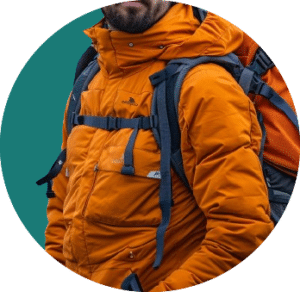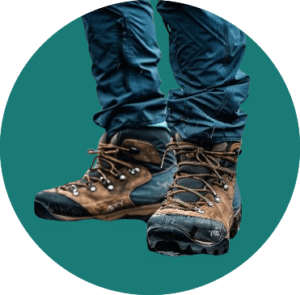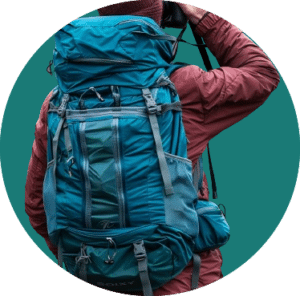How do I fit out?
From head to toe, get ready to challenge the peaks!
Here you’ll find all the essential equipment you’ll need during your stay.
What equipment do you need for hiking?
The Watse team recommends :

FOR THE HEAD :
– A bonnet or headband
– A hat or cap
– A buff or scarf to protect against dust and sun
– Sunglasses, preferably category 4, and case
– Sun cream with a minimum sun protection factor of 40
– A bonnet or headband
– A hat or cap
– A buff or scarf to protect against dust and sun
– Sunglasses, preferably category 4, and case
– Sun cream with a minimum sun protection factor of 40

FOR THE BUST :
– Breathable, comfortable short-sleeved T-shirts (natural fibers preferred)
– Breathable, comfortable long-sleeved T-shirts (natural fibers preferred)
– Microfleece or equivalent (second layer)
– Fleece or softshell jacket
– Protective goretex jacket (third layer)
– Lightweight down jacket
– Breathable, comfortable short-sleeved T-shirts (natural fibers preferred)
– Breathable, comfortable long-sleeved T-shirts (natural fibers preferred)
– Microfleece or equivalent (second layer)
– Fleece or softshell jacket
– Protective goretex jacket (third layer)
– Lightweight down jacket

FOR THE LEGS :
– Hiking pants convertible into shorts or not
– Lightweight protective pants such as Goretex
– Gaiters or stop touts at the beginning of the season
– Hiking pants convertible into shorts or not
– Lightweight protective pants such as Goretex
– Gaiters or stop touts at the beginning of the season

FOR FEET/HANDS :
– Comfortable socks. Take one size smaller to avoid blisters
– Comfortable, waterproof high-top hiking shoes: do not leave with new shoes to avoid blisters
– Comfortable shoes for the evening at lodgings
– Light fleece-type gloves
– Comfortable socks. Take one size smaller to avoid blisters
– Comfortable, waterproof high-top hiking shoes: do not leave with new shoes to avoid blisters
– Comfortable shoes for the evening at lodgings
– Light fleece-type gloves

MISCELLANEOUS :
– Light hiking backpack, approx. 30 to 40 liters. Bring a rain cape
– Sleeping bag (comfortable temperature 0°)
– Walking poles recommended
– Personal toiletries
– Towel, soap
– Water bottle for the day’s walk, minimum 1.5 L
– Multi-purpose knife
– Camera
– Light hiking backpack, approx. 30 to 40 liters. Bring a rain cape
– Sleeping bag (comfortable temperature 0°)
– Walking poles recommended
– Personal toiletries
– Towel, soap
– Water bottle for the day’s walk, minimum 1.5 L
– Multi-purpose knife
– Camera
Trekking equipment
The Watse team recommends :

FOR THE HEAD :
– A bonnet or headband
– A hat or cap
– A buff or scarf against dust and sun
– Sunglasses, preferably category 4, and case
– Sun cream with a minimum SPF of 40
– A bonnet or headband
– A hat or cap
– A buff or scarf against dust and sun
– Sunglasses, preferably category 4, and case
– Sun cream with a minimum SPF of 40

FOR THE BUST :
– Breathable, comfortable short-sleeved T-shirts (natural fibers preferred)
– Breathable, comfortable long-sleeved T-shirts (natural fibers preferred)
– Microfleece or equivalent (second layer)
– Fleece or softshell jacket
– Protective goretex jacket (third layer)
– Lightweight down jacket
– Breathable, comfortable short-sleeved T-shirts (natural fibers preferred)
– Breathable, comfortable long-sleeved T-shirts (natural fibers preferred)
– Microfleece or equivalent (second layer)
– Fleece or softshell jacket
– Protective goretex jacket (third layer)
– Lightweight down jacket

FOR THE LEGS :
– Hiking pants convertible into shorts or not
– Lightweight protective pants such as Goretex
– Gaiters or stop touts at the beginning of the season
– Hiking pants convertible into shorts or not
– Lightweight protective pants such as Goretex
– Gaiters or stop touts at the beginning of the season

FOR FEET/HANDS :
– Comfortable socks. Take one size smaller to avoid blisters
– Comfortable, waterproof high-top hiking shoes: do not leave with new shoes to avoid blisters
– Comfortable shoes for the evening at lodgings
– Light fleece-type gloves
– Comfortable socks. Take one size smaller to avoid blisters
– Comfortable, waterproof high-top hiking shoes: do not leave with new shoes to avoid blisters
– Comfortable shoes for the evening at lodgings
– Light fleece-type gloves

MISCELLANEOUS :
– Light hiking backpack, approx. 30 to 40 liters. Bring a rain cape
– Sleeping bag (comfortable temperature 0°)
– Walking poles recommended
– Personal toiletries
– Towel, soap
– Water bottle for the day’s walk, minimum 1.5 L
– Multi-purpose knife
– Camera
– Light hiking backpack, approx. 30 to 40 liters. Bring a rain cape
– Sleeping bag (comfortable temperature 0°)
– Walking poles recommended
– Personal toiletries
– Towel, soap
– Water bottle for the day’s walk, minimum 1.5 L
– Multi-purpose knife
– Camera
What equipment do you need for snowshoeing?
The Watse team recommends :

FOR THE HEAD :
– A beanie
– A hat or cap
– A buff or scarf to protect against dust and sun
– Sunglasses, preferably category 4, and case
– Sun cream with a minimum sun protection factor of 40
– A beanie
– A hat or cap
– A buff or scarf to protect against dust and sun
– Sunglasses, preferably category 4, and case
– Sun cream with a minimum sun protection factor of 40

FOR THE BUST :
– Breathable, comfortable short-sleeved T-shirts (natural fibers preferred)
– Breathable, comfortable long-sleeved T-shirts (natural fibers preferred)
– Microfleece or equivalent (second layer)
– Fleece or softshell jacket
– Protective goretex jacket (third layer)
– Down jacket
– Breathable, comfortable short-sleeved T-shirts (natural fibers preferred)
– Breathable, comfortable long-sleeved T-shirts (natural fibers preferred)
– Microfleece or equivalent (second layer)
– Fleece or softshell jacket
– Protective goretex jacket (third layer)
– Down jacket

FOR THE LEGS :
– Hiking pants or ski pants
– Lightweight protective pants such as Goretex
– Gaiters
– Fleece or other tights
– Hiking pants or ski pants
– Lightweight protective pants such as Goretex
– Gaiters
– Fleece or other tights

FOR FEET/HANDS :
– Comfortable socks. Take one size smaller to avoid blisters
– Comfortable and waterproof high-top hiking boots: do not leave with new boots to avoid blisters
– Comfortable shoes for the evening at lodgings
– Lightweight fleece-type gloves
– Warm, waterproof gloves
– Comfortable socks. Take one size smaller to avoid blisters
– Comfortable and waterproof high-top hiking boots: do not leave with new boots to avoid blisters
– Comfortable shoes for the evening at lodgings
– Lightweight fleece-type gloves
– Warm, waterproof gloves

MISCELLANEOUS :
– Light hiking backpack, approx. 30 to 40 liters. Bring a rain cape
– Casual evening wear
– Walking poles (supplied if required)
– Personal toiletries, towel, soap
– Water bottle for the day’s walk, minimum 1.5 L
– Multi-purpose knife
– Survival blanket
– Headlamp and spare batteries
– Meat bag
– Camera
– Light hiking backpack, approx. 30 to 40 liters. Bring a rain cape
– Casual evening wear
– Walking poles (supplied if required)
– Personal toiletries, towel, soap
– Water bottle for the day’s walk, minimum 1.5 L
– Multi-purpose knife
– Survival blanket
– Headlamp and spare batteries
– Meat bag
– Camera
Skiing equipment
The Watse team recommends :

FOR THE HEAD :
– A bonnet or headband
– A hat or cap
– A buff or scarf against dust and sun
– Sunglasses, preferably category 4, and case
– Sun cream with a minimum SPF of 40
– A bonnet or headband
– A hat or cap
– A buff or scarf against dust and sun
– Sunglasses, preferably category 4, and case
– Sun cream with a minimum SPF of 40

FOR THE BUST :
– Breathable, comfortable short-sleeved T-shirts (natural fibers preferred)
– Breathable, comfortable long-sleeved T-shirts (natural fibers preferred)
– Microfleece or equivalent (second layer)
– Fleece or softshell jacket
– Protective goretex jacket (third layer)
– Lightweight down jacket
– Breathable, comfortable short-sleeved T-shirts (natural fibers preferred)
– Breathable, comfortable long-sleeved T-shirts (natural fibers preferred)
– Microfleece or equivalent (second layer)
– Fleece or softshell jacket
– Protective goretex jacket (third layer)
– Lightweight down jacket

FOR THE LEGS :
– Hiking pants convertible into shorts or not
– Lightweight protective pants such as Goretex
– Gaiters or stop touts at the beginning of the season
– Hiking pants convertible into shorts or not
– Lightweight protective pants such as Goretex
– Gaiters or stop touts at the beginning of the season

FOR FEET/HANDS :
– Comfortable socks. Take one size smaller to avoid blisters
– Comfortable, waterproof high-top hiking shoes: do not leave with new shoes to avoid blisters
– Comfortable shoes for the evening at lodgings
– Light fleece-type gloves.
– Comfortable socks. Take one size smaller to avoid blisters
– Comfortable, waterproof high-top hiking shoes: do not leave with new shoes to avoid blisters
– Comfortable shoes for the evening at lodgings
– Light fleece-type gloves.

MISCELLANEOUS :
– Light hiking backpack, approx. 30 to 40 liters. Bring a rain cape
– Sleeping bag (comfortable temperature 0°)
– Walking poles recommended
– Personal toiletries
– Towel, soap
– Water bottle for the day’s walk, minimum 1.5 L
– Multi-purpose knife
– Camera
– Light hiking backpack, approx. 30 to 40 liters. Bring a rain cape
– Sleeping bag (comfortable temperature 0°)
– Walking poles recommended
– Personal toiletries
– Towel, soap
– Water bottle for the day’s walk, minimum 1.5 L
– Multi-purpose knife
– Camera
Mountaineering equipment
The Watse team recommends :

FOR THE HEAD :
– A beanie and a cap
– A buff or a scarf
– Sunglasses preferably category 4 and case
– Ski mask
– Sunscreen and lip shield very – Sunscreen minimum index 40
high protection (index 50)
– A beanie and a cap
– A buff or a scarf
– Sunglasses preferably category 4 and case
– Ski mask
– Sunscreen and lip shield very – Sunscreen minimum index 40
high protection (index 50)

FOR THE BUST :
– Breathable, comfortable short-sleeved T-shirts (natural fibers preferred)
– Breathable, comfortable long-sleeved T-shirts (natural fibers preferred)
– Microfleece or equivalent (second layer)
– Fleece or softshell jacket
– Goretex-type protective jacket (third layer)
– Fleece or thick down jacket for the bottom of the bag
– Breathable, comfortable short-sleeved T-shirts (natural fibers preferred)
– Breathable, comfortable long-sleeved T-shirts (natural fibers preferred)
– Microfleece or equivalent (second layer)
– Fleece or softshell jacket
– Goretex-type protective jacket (third layer)
– Fleece or thick down jacket for the bottom of the bag

FOR THE LEGS :
– Thermal tights made of modern fibers
– Goretex-type protective pants
– Gaiters
– Thermal tights made of modern fibers
– Goretex-type protective pants
– Gaiters

FOR FEET/HANDS :
– Warm socks. Take one size smaller to avoid blisters
– High-mountain shoes with rigid soles that can be fitted with crampons (crampons can be rented)
– Light fleece gloves
– Warm mittens.
– Warm socks. Take one size smaller to avoid blisters
– High-mountain shoes with rigid soles that can be fitted with crampons (crampons can be rented)
– Light fleece gloves
– Warm mittens.

MISCELLANEOUS :
– Light mountaineering backpack, approx. 30-40 liters. Bring a rain cape
– Silk sheet (mandatory for refuges) no need for sleeping bag
– Walking sticks
– Small personal first-aid kit (painkillers, second skins, earplugs)
– Water bottle for the day’s walk, minimum 1 L
– Headlamp and batteries
– Thermos flask minimum 0.5 L
– Energy bars or dried fruit
– Light mountaineering backpack, approx. 30-40 liters. Bring a rain cape
– Silk sheet (mandatory for refuges) no need for sleeping bag
– Walking sticks
– Small personal first-aid kit (painkillers, second skins, earplugs)
– Water bottle for the day’s walk, minimum 1 L
– Headlamp and batteries
– Thermos flask minimum 0.5 L
– Energy bars or dried fruit
Need more information?
Choose your adventure
Our advantages
INSURANCE
Special outdoor travel insurance, assistance
PAYMENT IN INSTALMENTS
Secure payments, possibility to pay in instalments free of charge
LISTENING AND SUPPORT
We guide you every step of the way, from A to Z, ensuring constant support and dedicated attention to make your stay more enjoyable
24/7 SUPPORT
Assistance and insurance to obtain a quick and efficient solution
